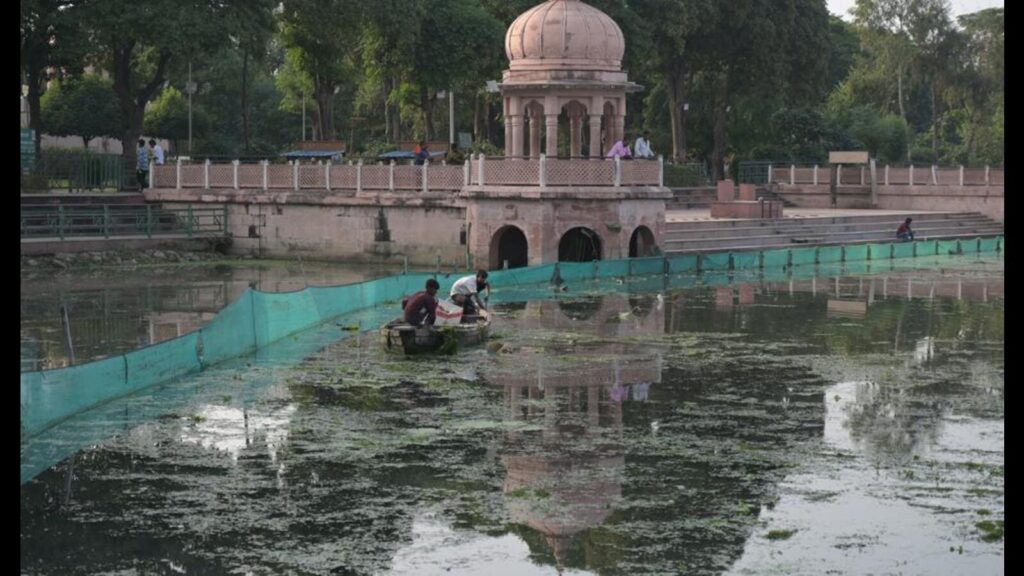Chhath Puja: Devotees ready, ghats decked up, but Lucknow’s Gomti unfit for bathing

LUCKNOW Ghats have been decked up and thousands of devotees are set to take a holy dip in the Gomti during Chhath Puja celebrations on Thursday, but the quality of water has been classified in the ‘E’ category, indicating it is unfit for bathing. The district administration has planned a ‘chemical cure’ to bring the river back to its pristine levels by the time the faithful perform rituals.

The river water, particularly from areas like Kudiaghat, Nishatganj Bridge, Barrage, and Pipraghat, is only fit for irrigation, industrial cooling, and controlled waste disposal. It is also not suitable for aquatic life due to dangerously low dissolved oxygen (DO) levels, said experts.
Recent water quality tests highlighted a concerning trend. On October 30, the dissolved oxygen level was recorded at a dangerously low 1.63 mg/l. It improved slightly on October 31 to 1.90 mg/l, and by November 5, the DO rose to 2.32 mg/l at the Gomti Barrage. However, even this level remains far below the required threshold for sustaining aquatic life. The aquatic life can survive at more than 4 mg/l DO level.
When asked about dirty water in the river, municipal commissioner Inderjit Singh said: “We are confident that by Thursday, the river will be cleaner than ever as we are ready to address the issue at the ghats. To remove the sludge, we have already begun flushing water at various points. Additionally, we are utilising the filtration plant at Gaughat to treat the water with sodium hypochlorite and bleaching powder.”
The filtered water is being directed from Gaughat to the barrage to improve quality. For further cleansing, a Jal Sansthan team is also treating the Gaughat-barrage stretch with chemicals. “To tackle solid waste, a skimmer is deployed to remove debris from the river. We’ve opened the barrier and released 15 MLD of water from Gaughat to barrage and it has further cleansed the river. The district magistrate also visited the area and noted that the water quality has improved,” the officer said.
The surface water quality is categorized from A to E, wherein water till category C can be consumed after conventional treatment while water in category A can be drunk. Water of category D is for propagation of wildlife and fish culture. Category E water is used for irrigation, industrial cooling and controlled waste disposal.
The water of the Gomti, throughout its course from Kudiaghat to Pipraghat, has largely remained in the ‘E’ category, reflecting severe contamination, particularly from Kudiaghat to Pipraghat. Only at Gaughat, where it enters the main city, does the water quality improve to a ‘D’ classification, which is also not fit for bathing.
One of the most alarming concerns is the dangerously high concentration of faecal coliform in the water. At various points along the river, these levels have been shockingly high. For instance, at Kudiaghat, the faecal coliform count was 35,000 MPN/100ml; at Mohan Meakins, it reached 46,000 MPN/100ml; at Nishatganj, it surged to 92,000 MPN/100ml; at the Gomti Barrage, the count reached 110,000 MPN/100ml, and at Pipraghat, it peaked at 130,000 MPN/100ml, according to reports of UPPCB.
This year, the annual process of releasing water into the Gomti from the Sharda Canal wasn’t undertaken. Irrigation department officials said, “With festive period shortly after monsoon, there is enough water in the river and it will not be feasible to release more water. However, to clean the surface water in the river, we are flushing water via the barrage everyday, for the past four days.”
Every year, about 150 cusecs water was released from the canal into Behta river and that flowed into the Gomti. It took three to four days for the water to reach the spot where Chhath Puja is performed.
Experts warn that drinking water from these areas without proper treatment could lead to severe stomach ailments. Doctors said in case people have sensitive skin, they can take a few measures to ensure water does not harm their skin. “Follow Swachch Bharat protocol. All must ensure they do not throw anything into the river that may harm others coming for the dip. People with sensitive skin can take a bath again at home after returning from the ghats,” said Dr Sheetal Verma, senior faculty, King George’s Medical University (KGMU).
Experts said in such a situation when water quality is not up to mark, the best possible way is to organise Chhath Puja in the upper stream of Kudia Ghat. “This will ensure the best possible quality of water for devotees who stand knee-deep or even take a holy dip in the river,” said Venkatesh Dutta, environmentalist and professor at the School of Earth & Environmental Aciences, Babasaheb Bhimrao Ambedkar University.
Prabhunath Rai, an activist who has been organising Chhath Puja for years, said: “At least two-feet water level needs to rise. They opened the barrage and this made way for dirt to reach ghats from the other side of barrage.”
Ensure all arrangements for devotees: Min tells officials
UP finance minister and in-charge for Lucknow, Suresh Khanna on Wednesday, directed officials to ensure all arrangements for devotees during Chhath Puja.
During an inspection at the Lakshman Mela ground, he asked officials to make separate entry and exit gates for devotees to avoid any inconvenience. “The administration will ensure that devotees will not face any problem,” said the minister.
He said barricading should be in place to keep devotees safe from deep water while police be deployed with equipment to tackle any situation. “Use of single-use plastic should be avoided. Garbage should not be dumped at any place,” he emphasised.




